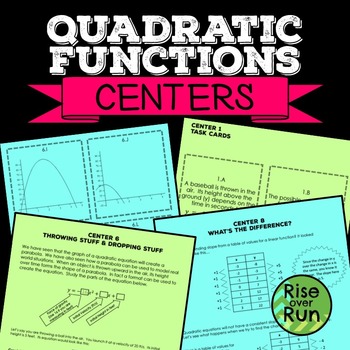Quadratic Formula, Factoring Quadratics, & Graphing Quadratic Functions Activity
- PDF
Also included in
- Take your Quadratics Unit to the next level with these resources to help your students learn about quadratic equations, graphs, and the situations they represent. Many activities include real world connections. They are engaging and rigorous. Vertex form and standard form is included.Price $24.00Original Price $30.97Save $6.97
- Do you love discovery learning, collaboration, hands-on activities, and projects that help students make sense of the math they are learning? This curriculum is packed with engaging and challenging Algebra I and 8th grade math resources for the whole year. A variety of activities, inquiry learningPrice $350.00Original Price $677.94Save $327.94
- This curriculum bundle includes a variety of activities, assessments, games, group activities, projects, inquiry lessons, guided notes, and more for teaching Algebra I CCSS standards. The activities are centered on discovery learning and engaging activities with real world connections. Lessons helpPrice $225.00Original Price $445.21Save $220.21
- A bundle of engaging card sorts, group activities, math centers, and games to help your students practice and learn Algebra 1 standards. The included resources cover a variety of topics and could be used throughout the year to supplement your curriculum. They are fun and challenging!Price $40.00Original Price $60.95Save $20.95
Description
This pack includes all the major concepts of working with quadratics in standard form! Engage students as they collaborate and learn about quadratic functions.
At each station, a guide sheet leads students through a new concept. Then, task cards provide practice. You could use the centers as review, or let students teach themselves each concept following the guide sheet.
Answers for task cards are provided.
Here's an overview of each center:
Center 1: Finding the Vertex
Students use the formula for axis of symmetry to find the vertex. They also think about what the vertex means for real world situations.
Center 2: Observations on the Graphing Calculator
Students practice entering equations into a graphing calculator and finding the vertex and intercepts.
Center 3: Finding the Zeros by Factoring
Students use their factoring skills to find the x-intercepts of quadratic functions.
Center 4: Finding Zeros by Completing the Square
Students use the method of completing the square to find the x-intercepts of quadratic functions.
Center 5: Finding Zeros using the Quadratic Formula
Students use the quadratic formula to find the x-intercepts of quadratic functions.
Center 6: Throwing Stuff and Dropping Stuff
Students see how quadratic functions can be used to model items thrown or dropped. They match stories, equations, and graphs.
Center 7: Parent Function
Students see the parent function of quadratics and experiment to see how changing the equation changes the graph.
Center 8: What’s the Difference?
Students find the second difference of quadratic tables of values and use it to distinguish quadratic and linear functions.
Students do not need to proceed through the centers in order. I recommend prepping the centers and then letting groups rotate through each one over a few class periods. (That way you only need to prep one set for each center!)
Each center will take about 20 minutes.
Check out the preview to see more!









